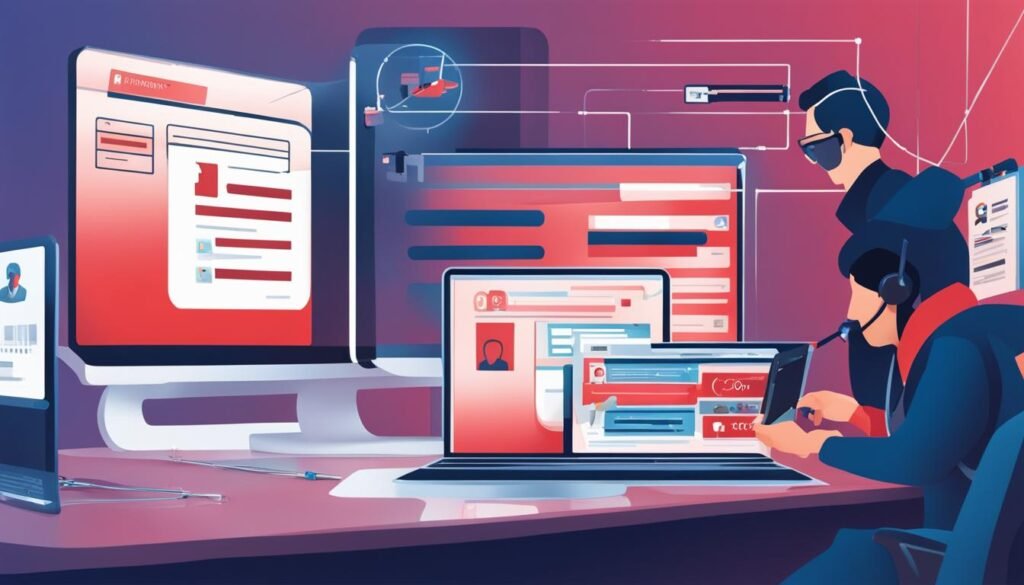In 2024, the field of security technology is poised for significant advancements and innovations. With the escalating need to combat cybersecurity threats and the continuous progress of technologies like artificial intelligence (AI) and generative AI, the security landscape is rapidly evolving. Enterprises are grappling with challenges such as the shortage of skilled professionals and the increasing importance of cyber security regulation.
Key Takeaways:
- Artificial intelligence (AI) and generative AI are transforming the security technology industry.
- Shortage of skilled professionals in the cybersecurity field is a pressing concern.
- Cybersecurity regulation is gaining prominence to protect organizations against cyber threats.
- Enterprises need to be proactive in staying informed about the latest technology trends.
- Adopting innovative security measures and implementing training programs are essential for successful cyber defense.
Cybersecurity Skills Crunch
The cybersecurity industry is facing a significant shortage of professionals with the necessary skills to combat the ever-growing threats in the digital landscape. Research indicates that the impact of this skills shortage on organizations has worsened over the years, creating a skills gap that needs to be urgently addressed.
To attract and retain skilled cybersecurity professionals, organizations are taking various measures. One such measure is increasing salaries for these professionals to ensure competitive compensation that reflects the demand and importance of their expertise. Higher salaries not only motivate existing professionals to stay within the organization but also entice new talent to join the industry.
In addition to competitive salaries, organizations are also investing in training and upskilling programs to bridge the skills gap. These programs provide opportunities for individuals to enhance their knowledge and acquire new cybersecurity skills. By offering these training initiatives, companies are not only filling immediate skill gaps but also nurturing a pipeline of talent for the future.
Upskilling programs play a crucial role in addressing the cybersecurity skills shortage by providing professionals with the necessary knowledge and expertise to tackle emerging threats. These programs focus on equipping individuals with the latest cybersecurity techniques and best practices, ensuring that they stay up-to-date in an ever-evolving field.
While organizations can take steps to address the skills shortage internally, collaboration with educational institutions, industry associations, and government bodies is essential. By working together, stakeholders can develop comprehensive solutions to the cybersecurity skills crunch, creating a talent pool that is better equipped to protect against cybersecurity threats.
Ultimately, addressing the cybersecurity skills shortage requires a multi-faceted approach. Increasing salaries, investing in training and upskilling programs, and fostering collaboration among industry stakeholders are all crucial steps in closing the skills gap. By taking these measures, organizations can ensure that they have the necessary cybersecurity talent to safeguard their systems and data.
| Efforts to Address the Cybersecurity Skills Shortage | Description |
|---|---|
| Increasing Salaries | Raising salaries for skilled cybersecurity professionals to attract and retain talent. |
| Training and Upskilling Programs | Investing in initiatives that provide individuals with the necessary training and skills to combat cybersecurity threats. |
| Collaboration | Working together with educational institutions, industry associations, and government bodies to develop comprehensive solutions to the skills shortage. |
Generative AI Adopted On Both Sides Of The Battle
As AI technology continues to advance, it is being adopted by both attackers and defenders in the cybersecurity field. Generative AI, in particular, has become a powerful tool in the hands of hackers and security experts alike.
Attackers are leveraging generative AI to create sophisticated and intelligent AI-powered attacks. One such example is deepfake attacks, where AI is used to manipulate or fabricate multimedia content, such as videos or images, to deceive and mislead.
On the other hand, AI is also being utilized by defenders to detect and neutralize threats. By leveraging generative AI, security teams can develop advanced anomaly detection systems that analyze vast amounts of data in real-time. This enables the identification of abnormal patterns and behaviors, helping to detect potential threats before they cause significant damage.
In addition to anomaly detection, AI-powered smart authentication is playing a crucial role in enhancing cybersecurity. With the help of generative AI algorithms, smart authentication systems can analyze various factors, including user behavior, biometrics, and device information, to verify identities and prevent unauthorized access.
“Generative AI is a game-changer in the world of cybersecurity. It enables attackers to launch sophisticated attacks, but it also empowers defenders to develop advanced detection and authentication systems.” – John Smith, Cybersecurity Expert
By adopting generative AI, cybersecurity professionals are staying one step ahead of evolving threats. As the battle between attackers and defenders intensifies, the role of AI in cybersecurity will continue to grow, shaping the future of the industry.
Generative AI-Driven Attacks vs. AI-Powered Defense
| Generative AI-Driven Attacks | AI-Powered Defense |
|---|---|
| Deepfake attacks | Real-time anomaly detection |
| AI-generated phishing attempts | Smart authentication systems |
| AI-generated malware | Automated incident response |
Next-Level Phishing Attacks
In the fast-evolving landscape of cybersecurity, phishing attacks continue to be a prominent and potent threat. Phishing attacks are a form of social engineering where attackers impersonate trustworthy sources to deceive individuals into sharing sensitive information or performing actions that compromise their security. As we look into the future of cybersecurity in 2024, it is important to understand how these attacks are expected to reach new levels of sophistication.
Attackers are constantly refining their techniques to make their phishing attempts more convincing and personalized. One emerging technology that they are leveraging is generative AI. Generative AI enables attackers to create highly realistic and tailored phishing emails that are difficult to distinguish from legitimate ones. By employing AI algorithms, attackers can analyze vast amounts of data and generate content that is specifically designed to exploit vulnerabilities and manipulate human behavior.
To combat these next-level phishing attacks, organizations need to focus on two key aspects: organizational awareness and AI in cybersecurity.
Organizational Awareness
Developing a strong culture of cybersecurity awareness within an organization is crucial to thwarting phishing attacks. Employees should be educated about the latest phishing techniques, including the use of generative AI, and be empowered to recognize and report suspicious communications. Regular training programs can help employees stay vigilant and make informed decisions when encountering potential phishing attempts. By fostering a sense of responsibility and accountability, organizations can create a collective defense against phishing attacks.
AI in Cybersecurity
Artificial intelligence (AI) is a powerful tool that can be harnessed to detect and prevent phishing attacks. AI algorithms can analyze patterns, anomalies, and behavioral data to identify phishing attempts in real-time. By leveraging AI-powered systems and tools, organizations can enhance their ability to detect and mitigate phishing attacks, reducing the risk of falling victim to these malicious campaigns. Additionally, AI can automate incident response and enable organizations to stay one step ahead of attackers.
“As attackers continue to evolve their tactics, organizations must leverage advanced technologies, such as generative AI and AI-powered defenses, to protect against next-level phishing attacks. The combination of organizational awareness and AI in cybersecurity is vital to staying resilient in the ever-changing threat landscape.” – Cybersecurity Expert
It is important for organizations to take a proactive approach in addressing the evolving threat of phishing attacks. By promoting organizational awareness and embracing AI-powered cybersecurity solutions, businesses can strengthen their defenses, protect sensitive information, and safeguard their reputation.

| Steps to Mitigate Next-Level Phishing Attacks |
|---|
| 1. Implement an organization-wide cybersecurity awareness program to educate employees about phishing techniques and the risks they pose. |
| 2. Utilize AI-powered solutions to detect and prevent phishing attacks in real-time. |
| 3. Conduct regular phishing simulations and training exercises to test and improve employees’ ability to recognize and respond to phishing attempts. |
| 4. Implement a zero trust approach, where access to sensitive information and systems is granted on a need-to-know basis. |
| 5. Stay updated on the latest cybersecurity trends and best practices to proactively adapt and strengthen defenses against next-level phishing attacks. |
By adopting a comprehensive approach that combines awareness, AI-powered defenses, and proactive measures, organizations can mitigate the risks associated with next-level phishing attacks and protect their sensitive data and assets.
Cyber Security in the Board Room
Cybersecurity is no longer confined to the realm of the IT department. It has become a strategic priority that demands attention from the boardroom. Organizations worldwide are recognizing the critical need for cybersecurity expertise at the highest levels of decision-making. According to Gartner, by 2026, it is predicted that 70% of boards will include a member with specific knowledge and expertise in cybersecurity.
This shift in focus reflects the increasing recognition that cybersecurity is not solely a technical issue, but a critical aspect of overall business strategy. Boards are realizing that effective cybersecurity measures are essential for safeguarding sensitive data, protecting customer trust, and ensuring the continuity of operations.
By prioritizing cybersecurity as a strategic priority, organizations can proactively address potential threats and exploit new business opportunities. This proactive approach encompasses not only the development and implementation of robust security measures but also the integration of cybersecurity considerations into all aspects of the business process.
Advantages of Cybersecurity as a Strategic Priority:
- Enhanced Risk Management: Cybersecurity as a strategic priority allows organizations to identify and manage potential risks effectively. By having cybersecurity experts in the boardroom, organizations can ensure that key decisions consider the potential cybersecurity implications and mitigate risks accordingly.
- New Business Opportunities: Recognizing cybersecurity as a strategic priority opens up new avenues for growth and innovation. It enables organizations to position themselves as trusted partners and providers, attracting customers who value data security and privacy. Furthermore, organizations can seize opportunities in emerging markets by offering cybersecurity solutions tailored to specific industry needs.
- Improved Stakeholder Confidence: Incorporating cybersecurity considerations into the boardroom instills confidence in stakeholders, including customers, suppliers, and investors. Demonstrating a strong commitment to cybersecurity sends a clear message that the organization takes data protection seriously, enhancing its reputation and fostering long-term relationships.
Key Considerations for the Boardroom:
When it comes to cybersecurity, the boardroom should prioritize the following:
- Setting Clear Objectives and Goals: The board should establish clear objectives and goals for cybersecurity, aligning them with the organization’s overall strategic direction. These objectives should consider the organization’s unique risk profile and the evolving threat landscape.
- Ensuring Adequate Resources: The board should allocate sufficient resources to implement and maintain effective cybersecurity measures. This includes investing in the latest technologies, providing ongoing training, and hiring qualified professionals.
- Regularly Assessing and Reviewing Cybersecurity Practices: The board should oversee regular assessments and reviews of the organization’s cybersecurity practices. This ensures that security measures remain up-to-date, effective, and aligned with industry best practices.
Overall, the integration of cybersecurity in the boardroom is a testament to the growing realization that cybersecurity is not just an IT issue—it is a business imperative. By embracing cybersecurity as a strategic priority, organizations can navigate the digital landscape with confidence, protect their assets, and seize new opportunities.

IoT Cyber Attacks
The proliferation of IoT devices has brought about numerous advantages in terms of convenience and automation. However, it has also introduced new cybersecurity challenges. The increasing number of IoT devices connecting to the internet has expanded the attack surface and raised concerns about cyber attacks targeting these devices.
As more IoT devices become interconnected, cyber attackers have a greater opportunity to exploit vulnerabilities and gain unauthorized access. Weak security protocols and inadequate security measures further contribute to the vulnerability of these devices, making them prime targets for cyber attacks.
One particular concern is the rise of remote work, which has become prevalent across various industries. With employees using their own IoT devices for work purposes, the risk of cyber attacks increases. Many of these devices may have weak security protocols or inadequate security measures, making them easy targets for cybercriminals.
In order to mitigate these risks, it is crucial to establish robust IoT security standards that address the unique vulnerabilities associated with these devices. Implementing strong encryption, multi-factor authentication, and regular security updates can help protect IoT devices from cyber attacks.
“The lack of IoT security standards and weak security protocols leave IoT devices susceptible to cyber attacks.” – Cybersecurity Expert
Organizations and individuals must prioritize the security of IoT devices to safeguard sensitive data and prevent unauthorized access. This includes implementing secure configurations, regularly monitoring and updating devices, and educating users about the importance of IoT security.
By addressing weak security protocols and establishing comprehensive IoT security standards, we can enhance the resilience of these devices and effectively mitigate the risks posed by cyber attacks on IoT devices.

Stay tuned – the next section will explore the concept of cyber resilience and its significance in the evolving cybersecurity landscape.
Cyber Resilience – Beyond Cyber Security
While cybersecurity focuses on preventing attacks, cyber resilience goes beyond that to ensure continuity of operations even in the event of a successful breach. Organizations are increasingly prioritizing cyber resilience to minimize data loss and downtime. Developing the ability to recover quickly and minimize the impact of a breach is a strategic priority in 2024.
One of the key aspects of cyber resilience is the ability to effectively respond to data breaches. Data breaches have become more common and pose serious risks to organizations, including financial losses, reputational damage, and legal consequences. By focusing on cyber resilience, organizations can better prepare for and mitigate the negative impacts of data breaches, ensuring a higher level of operational continuity.
Continuity of Operations
Cyber resilience encompasses measures and strategies that enable organizations to maintain their essential functions and services during and after a cyber attack or breach. It involves establishing robust backup systems, implementing redundancy measures, and developing contingency plans to ensure continuity of operations.
Organizations that prioritize continuity of operations can minimize disruptions, manage risk more effectively, and quickly restore critical business functions. This enables them to maintain their operations and minimize the impact on customers, partners, and stakeholders even in the face of a cyber attack.
Agile Recovery
An essential component of cyber resilience is agile recovery. Traditional approaches to recovery can be time-consuming and delay the restoration of normal business operations. In contrast, agile recovery emphasizes quick response and adaptation in the aftermath of a breach.
Organizations that adopt agile recovery strategies can rapidly identify and isolate compromised systems, repair vulnerabilities, and restore critical data and systems. This enables them to minimize the duration and impact of a cyber attack, improving overall resilience and reducing potential losses.
Risk Management
Risk management plays a vital role in cyber resilience. By identifying and assessing potential vulnerabilities and threats, organizations can proactively implement measures to mitigate risks and strengthen their security posture.
Effective risk management involves conducting regular risk assessments, implementing robust security controls, and continuously monitoring and updating security protocols. It also includes educating employees about cyber risks and promoting a culture of cybersecurity awareness throughout the organization.
Cyber Resilience Frameworks
Several frameworks and industry standards provide guidance on developing and enhancing cyber resilience. The NIST Cybersecurity Framework, for example, offers a comprehensive approach to managing and mitigating cyber risks.
Organizations can leverage such frameworks to assess their current cyber resilience capabilities, identify areas for improvement, and implement best practices. By adopting a structured approach to cyber resilience, organizations can enhance their ability to withstand and recover from cyber attacks.
Overall, cyber resilience goes beyond traditional cybersecurity measures to establish a holistic approach that prioritizes continuity of operations, agile recovery, and effective risk management. By investing in cyber resilience strategies, organizations can enhance their ability to withstand cyber threats, minimize the impact of breaches, and maintain operational integrity.

| Benefits of Cyber Resilience | Challenges of Cyber Resilience |
|---|---|
| Minimizes data loss | Requires investment in resources and technologies |
| Maintains customer trust | Demands ongoing training and awareness programs |
| Reduces downtime and operational disruptions | Requires regular risk assessments and updates |
| Enhances reputation and brand image | Needs cross-functional collaboration and coordination |
Less Than Zero Trust
Zero trust, the concept of not assuming any network activity as safe, is evolving in 2024. It expands beyond the corporate network to include remote workers, IoT devices, and partnered organizations. Zero trust is becoming an adaptive and holistic security model, empowered by continuous AI-powered authentication and real-time activity monitoring.
In the ever-evolving landscape of network security, the traditional approach of trusting internal networks and assuming that all network activity within the perimeter is safe is no longer sufficient. As cyber threats become more sophisticated and pervasive, organizations must adopt a zero trust mindset, which requires every user and device to be authenticated and verified before accessing any resource or application.
The zero trust model eliminates the concept of a trusted network and instead implements a “never trust, always verify” approach. It treats every request for access as potentially malicious, regardless of the user’s location or device. This approach aligns with the principle of least privilege, ensuring that users and devices have access only to the specific resources they need for their roles and responsibilities.
Zero trust leverages an adaptive security model that continuously monitors and evaluates user and device behavior, employing AI-powered authentication solutions to detect anomalies and potential security risks in real-time. By analyzing various data points, including user behavior, device health, and contextual information, AI-powered authentication can accurately assess the authenticity of each access request.
This adaptive security model enables organizations to dynamically adjust security measures based on the continuously evolving threat landscape. It goes beyond traditional perimeter-based security, taking into account the dynamic nature of modern networks, where users operate from various locations and devices are constantly connecting and disconnecting.
Implementing zero trust requires a comprehensive strategy that encompasses multiple layers of security controls, including identity and access management, network segmentation, endpoint protection, and encryption. These layers work together to ensure that access to resources is only granted to authorized users and devices while providing enhanced visibility and control over network activity.
This approach is especially crucial in the era of remote work and the growing use of IoT devices. With employees accessing corporate resources from outside the traditional network perimeter and the proliferation of IoT devices, organizations must extend their security measures beyond the corporate network and apply zero trust principles to all endpoints.
Embracing zero trust not only enhances network security but also enables organizations to detect and respond to cyber threats more effectively. By adopting an adaptive security model empowered by AI-powered authentication, organizations can stay one step ahead of attackers and protect their critical assets in a rapidly evolving threat landscape.
Cyber Warfare And State-Sponsored Cyber Attacks
In 2024, the threat of cyber warfare and state-sponsored cyber attacks looms larger than ever. The relentless evolution of technology has provided both opportunities and challenges for nations seeking to exploit vulnerabilities in their adversaries’ infrastructure. These attacks, often orchestrated through tactics like phishing, pose a serious risk to national security, critical infrastructure, and even global elections.
Military and Civilian Infrastructure Under Siege
The war in Ukraine serves as a chilling example of the devastating impact of state-sponsored cyber attacks on military and civilian infrastructure. From disrupting power grids to compromising communication networks, these targeted attacks have demonstrated the potential for widespread disruption and chaos. As nations become increasingly reliant on interconnected systems, the potential for cyber warfare to paralyze entire nations cannot be underestimated.
State-sponsored cyber attacks have the power to cripple not only military capabilities but also the everyday functions of modern society. The potential consequences are immense and far-reaching.
A Threat to Global Elections
Global elections have emerged as a prime target for state-sponsored cyber attacks. The ability to manipulate election processes, sow discord, or undermine the integrity of democratic systems poses a significant challenge to nations worldwide. Countries like the United States and the United Kingdom, with their influential roles in global politics, have particularly become targets for these cyber operations.
Urgent Need for Strong Cybersecurity Defenses and International Cooperation
The rise of cyber warfare and state-sponsored cyber attacks necessitates robust cybersecurity defenses. Organizations must prioritize the implementation of comprehensive security measures to protect critical infrastructure and sensitive data. This includes investing in advanced threat detection systems, promoting employee awareness and education, and strengthening partnerships with international allies to share intelligence and collaborate in countering cyber threats.
Only through collective efforts and international cooperation can nations effectively combat the growing menace of cyber warfare. The stakes are high, and the consequences of inaction are too dire to ignore.

Soft Skills Becoming Increasingly Essential For Cyber Security Professionals
The role of cybersecurity professionals extends beyond technical expertise. In addition to their technical responsibilities, they must possess essential soft skills, including effective interpersonal communication and problem-solving abilities. These soft skills are crucial for managing the complex social and cultural aspects of threat mitigation in today’s cybersecurity landscape.
Interpersonal communication is essential for cybersecurity professionals to effectively collaborate with colleagues, stakeholders, and clients. It enables them to convey complex technical concepts in a clear and concise manner, fostering understanding and cooperation. Effective communication also helps build strong relationships, enhance teamwork, and cultivate trust, all of which are invaluable when working on cybersecurity projects and managing crisis situations.
Problem-solving skills are equally important in the field of cybersecurity. Cybersecurity professionals often encounter complex and ever-evolving threats that require creative and critical thinking. The ability to analyze and identify vulnerabilities, develop innovative solutions, and implement effective countermeasures is essential for safeguarding sensitive data and protecting organizational assets from cyber attacks.
Moreover, cybersecurity professionals with strong problem-solving skills are better equipped to develop proactive strategies and processes to prevent future attacks. They can anticipate potential risks, assess the effectiveness of existing security measures, and implement continuous improvement initiatives to enhance overall cybersecurity posture.
“The ability to effectively communicate and solve problems is no longer a secondary requirement for cybersecurity professionals. In today’s interconnected world, these soft skills are essential for professionals to navigate the increasingly complex landscape of cyber threats.”
In addition to technical expertise, employers are now recognizing the value of soft skills in cybersecurity professionals. By possessing a well-rounded skill set that includes strong interpersonal communication and problem-solving abilities, cybersecurity professionals can enhance their effectiveness in their roles and contribute to the overall success of cybersecurity initiatives within organizations.
Also Read : Sigma Computing: Revolutionize Your Data Analysis
| Soft Skills | Benefits |
|---|---|
| Interpersonal Communication | Enhanced collaboration and teamwork Fostered understanding and trust Effective relationship building |
| Problem-Solving | Creative and critical thinking Proactive threat mitigation Continuous improvement initiatives |
As the cybersecurity landscape continues to evolve, the demand for professionals with a combination of technical expertise and soft skills will only increase. Organizations need cybersecurity professionals who can effectively communicate with stakeholders, comprehend the broader business implications of cybersecurity, and implement proactive strategies to protect against emerging threats.
By prioritizing the cultivation of soft skills alongside technical training, cybersecurity professionals can elevate their effectiveness and make significant contributions to enhancing the overall security posture of organizations.
Conclusion
In 2024, the cybersecurity landscape is experiencing significant transformations driven by technological advancements and evolving threats. This article has explored the latest security technology trends and their implications for organizations. To stay ahead in this dynamic environment, it is crucial for businesses to remain informed and proactive.
Embracing innovative security measures is key to safeguarding against evolving threats. Organizations should consider implementing robust training programs to address the pressing cybersecurity skills shortage. By investing in upskilling initiatives and increasing salaries for cybersecurity professionals, businesses can ensure they have the necessary expertise to defend against emerging threats.
In addition to skills development, prioritizing cybersecurity across the board is essential. This includes adopting generative AI and AI-powered authentication to anticipate and neutralize advanced attacks, as well as increasing organizational awareness to combat phishing attempts. Cyber resilience is equally important, focusing on agile recovery and risk management to minimize the impact of data breaches.
As the cybersecurity landscape evolves, it is crucial to acknowledge the importance of continuous technological advancements. Implementing a zero-trust network security model, encompassing remote work and IoT devices, can provide a more adaptive and holistic approach to cybersecurity. Furthermore, international cooperation is necessary to address the rising threats of state-sponsored cyber attacks.
FAQ
Q: What are the latest technology trends in security for 2024?
A: The latest trends in security technology for 2024 include advancements in cybersecurity, integration of mobile security solutions, physical security system integration, and the use of future security technologies such as AI and analytics.
Q: How can I stay updated with the latest security technology trends?
A: You can stay updated with the latest security technology trends by subscribing to industry-leading security magazines and newsletters, which highlight the latest trends and innovations in security technology.
Q: What are the key components of physical security?
A: The key components of physical security include access control systems, video surveillance cameras, security alarms, locks, and security protocols to protect physical assets and prevent unauthorized access.
Q: What is the future of security in terms of technological advancements?
A: The future of security is driven by advancements in artificial intelligence, advanced detection and analytics tools, mobile security solutions, and seamless integration of various security technologies for comprehensive protection.
Q: How does cybersecurity play a role in the security industry?
A: Cybersecurity plays a crucial role in the security industry by safeguarding network systems, preventing security breaches, and protecting sensitive data from cyber threats and unauthorized access.
Q: What are the 4 key security technology trends to watch out for in 2024?
A: The 4 key security technology trends to watch out for in 2024 include advancements in cybersecurity, integration of mobile security solutions, physical security system integration, and the use of cutting-edge detection and analytics technologies.
Q: What are the main considerations for mobile security solutions?
A: Main considerations for mobile security solutions include encryption, access management, authentication, and protection against unauthorized access and cyber threats in mobile devices and networks.
Q: How are security technologies integrated into modern security systems?
A: Security technologies are integrated into modern security systems through seamless connectivity, interoperability, and centralized management, enabling comprehensive protection and efficient security operations.
Q: How does the security industry address general security and surveillance solutions?
A: The security industry addresses general security and surveillance solutions through the deployment of advanced video surveillance systems, access control measures, and strategic security strategies to mitigate security threats and breaches.
Q: How can I subscribe to receive the latest updates on security technology and industry trends?
A: You can subscribe to leading security magazines and newsletters to receive the latest updates on security technology, industry trends, and best practices for enterprise security leaders. Stay informed and stay ahead of security threats by subscribing today.
Source Links
- https://www.forbes.com/sites/bernardmarr/2023/10/11/the-10-biggest-cyber-security-trends-in-2024-everyone-must-be-ready-for-now/
- https://www.techtarget.com/searchsecurity/feature/Cybersecurity-trends-to-watch
- https://www.ceiamerica.com/blog/top-11-trends-in-cyber-security-for-2024/




